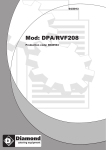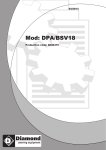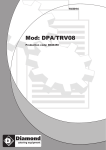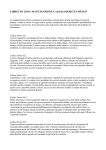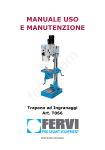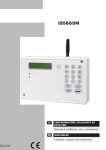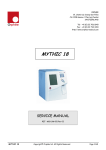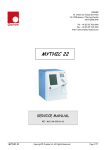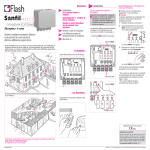Download Mod: DPA/CVV15
Transcript
04/2013 Mod: DPA/CVV15 Production code: 8046426 “SELF IN” - MANUALE D’INSTALLAZIONE, USO E M ANUTENZIONE PER VETRIN A VENTILATA CALDA UMIDA AD INCASSO - I - GB A010337 Rev. 3 - INSTALLATION, OPERATING AND M AINTENANCE M ANUAL FOR DROP-IN HUMIDIFIED HEATED DISPLAY CASES Page 1 of 11 I MANUALE D’INSTALLAZIONE, USO E MANUT ENZIONE PER VETRINA VENTILATA CALDA UMIDA AD INCASSO “SELF IN” 1.AVVERTENZE Leggere con attenzione il presente Manuale prima di procedere all’installazione. Il Manuale è concepito per dare all’utilizzatore le informazioni necessarie all’impiego dell’apparecchiatura in condizioni di sicurezza, dal trasporto al momento dello smantellamento. Il manuale deve essere conservato con cura, per essere disponibile in caso di future consultazioni. In caso di cessione dell’apparecchiatura, il manuale deve essere consegnato al nuovo utente. Per un corretto utilizzo dell’apparecchiatura: · Non manomettere i dispositivi di sicurezza; · Utilizzare solo per gli scopi specificatamente previsti; · Evitare la presenza di personale estraneo in prossimità dell’apparecchiatura; · Impiegare per la manutenzione esclusivamente personale qualificato; · Disattivare l’apparecchiatura in caso di guasto o di funzionamento irregolare; · Utilizzare esclusivamente ricambi forniti dal Costruttore o da questi indicati. ATTENZIONE: L’ACCESSO AL QUADRO ELETTRICO PRINCIPALE E A TUTTE LE ALTRE PARTI ELETTRICHE, SIA PER L’INSTALLAZIONE CHE PER LA MANUTENZIONE, È AUTORIZZATO SOLO A PERSONALE QUALIFICATO. Il Costruttore declina ogni responsabilità per i danni a cose o persone causati dalla mancata osservanza delle istruzioni e precauzioni contenute nel manuale. Per qualsiasi dubbio o necessità rivolgersi al RIVENDIT ORE. 2. INTRODUZIONE L’apparecchiatura è conforme alle Direttive 2004/108 CEE e 2006/95 CEE. Sono state inoltre applicate le norme CEI EN 60335-1, CEI EN 60335-2-49, CEI EN 60335-2-50, EN 55014, EN 61000-3-2 ed EN 61000-3-3. 3.DESCRIZIONE DELLE APPARECCHIATURE Le nostre VETRINE CALDE UMIDE VENTILATE sono costituite da una vasca con appoggiata sopra una vetrina. La regolazione della temperatura di esercizio avviene tramite termostato digitale. La regolazione dell’umidità di esercizio avviene tramite strumento digitale Livello dell’acqua nella bacinella che produce vapore viene regolarizzata da un sensore di livello. 4.TRASPORTO E MOVIMENTAZIONE Se l’apparecchiatura viene trasportata su pallet deve essere scaricata mediante carrello elevatore o altro macchinario di sollevamento idoneo, manovrati da personale addestrato. Eventuali errori di manovra potrebbero causare infortuni per schiacciamento. Qualora le superfici dell’apparecchiatura subissero urti esse sarebbero immediatamente rovinate. In questa fase deve essere vietata la sosta nelle immediate vicinanze a chiunque non sia coinvolto direttamente nell’operazione. Il personale che effettua la movimentazione deve essere munito di mezzi di protezione personale adeguati (ad es.: guanti da lavoro, scarpe antinfortunistiche). 5. CONDIZIONI DI UTILIZZO E CARATTERISTICHE TECNICHE L’apparecchiatura è stata progettata per mantenere ed esporre vivande riscaldate. contenute in appositi contenitori unificati, in locali adibiti alla ristorazione collettiva. Ogni altro impiego è da ritenersi improprio. ATTENZIONE: le apparecchiature non sono idonee per installazioni all’aperto e/o ambienti sottoposti alle azioni degli agenti atmosferici (pioggia, sole battente, ecc.). 5.1Comandi e controlli I dispositivi di comando sono raggruppati sul cruscotto descritto in Fig. 1. I componenti elettrici sono a norma. 5.2 Protezioni e dispositivi di sicurezza · · · Sensore di livello acqua: Sensore di livello che comanda l’ elettrovalvola carico acqua vaschetta vapore, riempie all’accensione dell’’interruttore umido B la vaschetta dell’acqua vapore e la mantiene al livello prestabilito. Nel caso in cui non ci sia acqua nella vaschetta vapore (guasto elettrovalvola o mancanza acqua) la resistenza non riscalda. L’accensione dell’interruttore umido funziona solo con interruttore vasca E acceso e termostato vasca acceso. Dispositivi di protezione individuale: Si consiglia l’uso di presine o guanti a causa della temperatura raggiungibile dai contenitori delle vivande o stoviglie riscaldate. Disposizioni particolari a copertura di rischio residuo: Limitare l’accesso alle sole persone addette, che devono essere informate sui pericoli potenziali dovuti alla temperatura. 6. INSTALLAZIONE 6.1Controllo ricevimento dell’apparecchiatura Prima di procedere al disimballo dell’imballo di protezione verificare l’integrità dello stesso Eventuali danni devono essere tempestivamente segnalati al vettore in ogni modo nessun apparecchio danneggiato potrà essere reso al costruttore senza preavviso e senza averne ottenuta preventiva autorizzazione scritta. 6.2Posizionamento Posizionare l’apparecchiatura lontano da correnti d’aria. La vetrina è concepita per l’utilizzo in un ambiente con temperatura di 22-25°C, al di fuori di queste condizioni ambientali, le prestazioni della vetrina possono cambiare. Posizionare l’apparecchiatura con l’eventuale aiuto di un transpallet. Se questo spostamento avviene dopo il disimballo, proteggere le superfici dagli urti. Una volta completata l’installazione è possibile togliere la pellicola protettiva. L’operazione va fatta molto lentamente per evitare che la colla rimanga sulle superfici. Qualora ciò avvenga, passare con kerosene o benzina. A010337 Rev. 3 Page 2 of 11 I 6.3Collegamenti elettrici Devono essere effettuati nel rispetto delle norme locali vigenti. Il circuito elettrico dell’apparecchiatura è progettato per funzionare con una tensione di alimentazione secondo le configurazioni riportate nella Tabella A, con frequenza a 50/60Hz. Vedere lo schema elettrico Fig. 2 riferibile al modello acquistato. Il collegamento elettrico avviene collegando la spina dell’apparecchiatura ad una presa del locale. Il cavo deve avere delle caratteristiche minime del tipo H05 RNF ed un conduttore di terra efficiente e correttamente dimensionato in base alla potenza totale dell’apparecchio e degli eventuali altri apparecchi o accessori collegati sulla stessa morsettiera (vedi targhetta) L’impianto elettrico di alimentazione dell’apparecchio deve essere dotato, a monte, di un interruttore automatico onnipolare correttamente dimensionato che garantisca un’apertura fra i contatti di almeno 3 mm. Il cavo di terra non deve essere interrotto. La sicurezza elettrica di questa apparecchiatura è assicurata unicamente quando sono soddisfatte le condizioni predette e se il sistema è in regola anche sotto il profilo dell’equipotenzialità. 6.4Collegamenti idrici Sotto il piano inferiore sono visibili i tubi di carico e scarico acqua. Collegare il tubo di carico dotato di valvola di intercettazione alla conduttura d’acqua. Collegare lo scarico della vasca al sifone della tubazione di scarico predisposta nel locale. I tubi predisposti sono da ½ “GAS sia per il carico che per lo scarico. Regolare la pressione del carico acqua tramite la valvola in modo tale che non ci siano schiz zi che fuoriescono dalla vaschetta. Il costruttore declina ogni responsabilità in caso di mancato rispetto di queste norme antinfortunistiche. 7. FUNZIONAMENTO / USO 7.1 Destinazioni d’uso e restrizioni · · · Questa apparecchiatura dovrà essere destinata solo all’uso per la quale è stata espressamente concepita: cioè il mantenimento dei cibi in contenitori GN. Ogni altro uso è da ritenersi improprio. Le macchine non sono adatte a lavorare in ambienti non controllati ,le apparecchiature non sono idonee per installazioni all’aperto e/o ambienti sottoposti alle azioni degli agenti atmosferici (pioggia, sole battente, ecc.). Limitare il tempo di apertura delle porte allo stretto indispensabile per l’introduzione o il prelievo degli alimenti. Prima di utilizzare l’apparecchiatura per la prima volta, pulire l’interno con acqua tiepida e sapone neutro. Evitare l’uso di detersivi o polveri abrasive, quindi sciacquare ed asciugare accuratamente. Il costruttore declina ogni responsabilità da usi non previsti dai prodotti 7.2Messa in funzione · · Inserire l’interruttore di protezione posto a monte dell’apparecchiatura. Premere l’interruttore generale A del pannello comandi (Fig. 1). L’accensione della spia incorporata indica che l’apparecchiatura è sotto tensione. REGOLAZIONE TEMPERATURA · Premere l’interruttore E di Fig. 1 per accendere i ventilatori della vasca, e poter accendere il termoregolatore. · Accendere il termoregolatore digitale F di Fig. 1, tenendo premuto per almeno 5 sec. il tasto 4 (vedi figura del termoregolatore) · Se la temperatura presente nella vetrina è inferiore al valore impostato, si accendono le resistenze e la spia 6 del termostato digitale F. · Regolare il termoregolatore digitale F alla temperatura desiderata,Il termoregolatore indica la temperatura all’interno della vetrina. · Premere l’interruttore H di Fig. 1 per accendere le lampade alogene riscaldanti, i ventilatori delle lampade vengono regolati da un termostato interno (funzionano solo quando la temperatura è maggiore di 40°C) · Premere l’interruttore I di Fig. 1 per accendere il termometro digitale con sonda a spillone. Termoregolatore digitale Legenda 1 – Display 2 – Pulsante “aumenta valore” 3 – Pulsante “decrementa valore” 4 – Premuto per almeno 5 sec. attiva la funzione stand-by, Pulsante “funzione di uscita” 5 – Pulsante “accede al setpoint”, accede ai menu’, conferma comandi, visualizza allarmi 6 – Led rosso acceso resistenza accesa 8 – Led rosso acceso allarme attivo, lampeggiante per allarme tacitato USO Nel corso del normale funzionamento lo strumento visualizza la temperatura rilevata dalla sonda all’interno della vetrina. Per visualizzare l’attuale valore del set point: (valore temperatura scelta), premere e rilasciare il tasto set, appare la scritta “set”, premere nuovamente il tasto set. Per modificare il valore del setpoint di lavoro premere e rilasciare il tasto set appare la scritta “set”, premere nuovamente il tasto set, appare il valore impostato, per modificarlo agire entro 15 secondi sui pulsanti ▲(2) o ▼(3) per aumentare o diminuire il valore; dopo la modifica, per memorizzare il nuovo valore premere il tasto set. Il setpoint è impostabile entr o i limiti di temperatura massima e minima stabiliti. SEGNALAZIONI ED ALLARMI ‘E1’ sul visualizzatore indica sonda termostato guasta indicano una delle seguenti anomalie: tipo di sonda vasca non corretta, sonda vasca difettosa, difetto nei collegamenti; controllare l’integrità della sonda e la correttezza del collegamento strumento-sonda. “AH1” sul visualizzatore indica allarme di alta temperatura indica che il valore letto è maggiore al valore max impostato dopo il tempo prestabilito; non causa nessun effetto sulla regolazione, l’allarme rientra quando la temperatura scende al di sotto del valore max. “AL1” sul visualizzatore indica allarme di bassa temperatura indica che il valore letto è minore al valore min impostato dopo il tempo prestabilito; non causa nessun effetto sulla regolazione, l’allarme rientra quando la temperatura sale al di sopra del valore min. La modifica dei PARAMETRI DI CONFIGURAZIONE del termostato, fissati dal costruttore, deve essere eseguita solo da personale qualificato utilizzando le istruzioni dello strumento. · REGOLAZIONE UMIDITA (E’ POSSIBILE REGOLARE L’UMIDITA’ SOLO CON TERMOREGOLATORE VASCA ACCESO) · Premere l’interruttore B del pannello comandi (Fig. 1). L’accensione della strumento C indica il valore di umidità all’interno della vetrina. A010337 Rev. 3 Page 3 of 11 I · · · Accendere lo strumento digitale C di Fig. 1, tenendo premuto per almeno 5 sec. il tasto 4 (vedi figura del regolatore) Se l’umidità presente nella vetrina è inferiore al valore impostato, si accende la resistenza e la spia 6 del termostato digitale. Il livello dell’acqua della bacinella dell’acqua che produce vapore viene regolarizzato da un sensore di livello. La spia D (fig.1) si accende nel momento del carico acqua, se rimane accesa indica un guasto nel carico acqua e la mancanza d’acqua nella bacinella. Regolatore umidità Legenda 1 – Display 2 – Pulsante “aumenta valore” 3 – Pulsante “decrementa valore” 4 – Premuto per almeno 5 sec. attiva la funzione stand-by, Pulsante “funzione di uscita” 5 – Pulsante “accede al setpoint”, accede ai menu’, conferma comandi, visualizza allarmi 6 – Led rosso acceso fisso resistenza accesa 8 – Led rosso acceso allarme attivo, lampeggiante per allarme tacitato USO Nel corso del normale funzionamento lo strumento visualizza l’umidità rilevata dalla sonda . Per modificare il valore del setpoint di lavoro premere e rilasciare il tasto set appare la scritta “set”, premere nuovamente il tasto set, appare il valore impostato, per modificarlo agire entro 15 secondi sui pulsanti ▲(2) o ▼(3) per aumentare o diminuire il valore; dopo la modifica, per memorizzare il nuovo valore premere il tasto set. Il setpoint è impostabile entr o i limiti di umidità massima e minima stabilit (da 40% a 85%). SEGNALAZIONI ED ALLARMI ‘E1’ sul visualizzatore indica sonda guasta indicano una delle seguenti anomalie: tipo di sonda non corretta, sonda difettosa, difetto nei collegamenti; controllare l’integrità della sonda e la correttezza del collegamento strumento-sonda. “AH1” sul visualizzatore indica allarme di alta indica che il valore letto è maggiore al valore max impostato dopo il tempo prestabilito; non causa nessun effetto sulla regolazione, l’allarme rientra quando il valore scende al di sotto del valore max. “AL1” sul visualizzatore indica allarme di bassa indica che il valore letto è minore al valore min impostato dopo il tempo prestabilito; non causa nessun effetto sulla regolazione, l’allarme rientra quando il valore sale al di sopra del valore min. La modifica dei PARAMETRI DI CONFIGURAZIONE, fissati dal costruttore, deve essere eseguita solo da personale qualificato utilizzando le istruzioni dello strumento. 7.3Spegnimento totale In occasione della messa fuori servizio per un lungo periodo devono essere osservate le seguenti prescrizioni: · Spegnere l’interruttore generale A. · Disattivare l’alimentazione elettrica a monte. · Estrarre tutti gli alimenti dalla vasca/piano o vetrina e pulire sia l’interno che gli accessori. · Lasciare le porte socchiuse nelle vetrine perché vi sia ricambio d’aria e non si formino odori sgradevoli. · Proteggere le superfici in acciaio inox con un velo di olio di vaselina. Allo scopo passare energicamente un panno appena imbevuto con l’olio. · Arieggiare periodicamente i locali. 8. PULIZIA E MANUTENZIONE 8.1 Manutenzione ordinaria La manutenzione ordinaria e preventiva consiste essenzialmente nella pulizia settimanale delle parti in acciaio inox con acqua tiepida e sapone, seguita da un risciacquo abbondante ed un’accurata asciugatura. L’operazione di pulizia deve essere eseguita solo dopo aver staccato l’alimentazione elettrica a monte dell’apparecchiatura. Attenzione: · Evitare assolutamente l’uso di prodotti detergenti abrasivi o corrosivi e di attrezzi come pagliette, spazzole o raschietti metallici. · Varechina, acido cloridrico ed altri composti contenenti cloro danneggiano l’acciaio inox. · Le parti colorate devono essere pulite con cera ai siliconi. · Il pavimento sotto l’apparecchio non deve essere lavato con sostanze corrosive che potrebbero sviluppare vapori che danneggiano l’apparecchiatura. · Durante la pulizia non lavare con getti d’acqua l’apparecchiatura. 8.2 Manutenzione straordinaria La manutenzione straordinaria avviene in caso di guasto od anomalia da parte di personale qualificato, possibilmente con l’apparecchiatura disconnessa dalla rete di alimentazione. In questo ambito possono essere necessarie riparazioni o sostituzioni. Le parti difettose devono essere sostituite solo con materiali e componenti identici a quelli originali o indicati dal Fornitore. In caso di sostituzione di componenti o modifica sull’apparecchiatura eseguita dall’utilizzatore senza il consenso scritto del Costruttore, o con ricambi non autorizzati, la garanzia decade immediatamente. 8.3 Possibili anomalie Per eventuali anomalie vedi SEGNALAZIONI ED ALLARMI DEL T ERMOSTATO DIGITALE. L’interruttore umido B per il carico acqua vaschetta e lo strumento umido C non funzionano se non viene prima acceso il termoregolatore vasca F. Se la spia carico acqua D rimane sempre accesa indica un guasto nel carico acqua e la conseguente mancanza d’acqua nella bacinella, in questa condizione di guasto la resistenza della vaschetta vapore non funziona. Se dopo aver effettuato i controlli indicati non si ottiene un funzionamento corretto, spegnere l’apparecchiatura e contattare immediatamente il fornitore. 9. SMANTELLAMENTO Alla fine della sua vita utile, l’apparecchiatura dovrà essere esclusa dalla rete elettrica prima di procedere allo smontaggio dei vari componenti. Si dovrà fare attenzione alle possibilità di infortunio connesse con la forma ed il peso di ciascun componente. Il simbolo riportato sul prodotto indica che esso non deve essere considerato un rifiuto domestico ma l’apparecchiatura deve essere smaltita nel rispetto delle leggi vigenti. Le varie parti (componenti elettrici, tubi in gomma, guaine passacavi, ecc.) andranno selezionate per ottenere il miglior risultato possibile in termini di rispetto per l’ambiente nel rispetto delle leggi vigenti. GB A010337 Rev. 3 Page 4 of 11 INSTALLATION, OPERAT ING AND MAINTENANCE MANUAL FOR BUILT-IN HUMIDIFIED HEATED DISPLAY CASES 1. WARNINGS Read this manual carefully before beginning installation. This manual is aimed at providing the user with all the information necessary for the safe functioning of the equipment, from its transportation to its dismantling. This manual must be looked after carefully so that it is available for future reference. In the event the equipment is sold, the manual must also be handed over to the new user. In order to use the equipment cor rectly: · Do not tamper the safety devices; · Use the equipment only for the purpose for which it was specifically designed; · Keep unauthorized personnel away from the equipment; · Have maintenance performed exclusively by qualified personnel; · Switch off the equipment in the event of a fault or defective working; · Only use spare parts supplied or indicated by the Manufacturer. ATTENTION: ACCESS TO SWITCH-BOARD AND TO OTHER ELECTRICAL PARTS – BOTH FOR INSTALLATION AND FOR MAINTENANCE PURPOSES - IS ALLOWED ONLY TO QUALIFIED PERSONNEL. The Manufacturer declines all responsibility for damage to property or bodily injury which result from non-compliance with the instructions and warnings contained herein. For any doubt or need whatsoever, contact the DEALER. 2. INTRODUCTION The equipment conforms to the EEC Directives 2004/108 CEE e 2006/95 CEE. In addition, the following standards have also been applied: CEI EN 60335-1, CEI EN 60335-2-49, CEI EN 60335-2-50, EN 55014, EN 61000-3-2 and EN 61000-3-3. 3. DESCRIPTION OF THE EQUIPMENT Our humidified heated dislay case are made up of a sink with a showcase on top. The working temperature is regulated by an electronic thermostat. The humidity is regulated by an electronic instrument. The water level of the steam producer drain pan adjusted by a level sensor. 4. TRANSPORTATION AND HANDLING If the equipment is transported on a pallet, it must be unloaded using a skilled personnel-operated lift truck or other appropriate lifting means. Manoeuvring errors might cause injury as a result of crushing. Any blows to the surfaces of the equipment will result in immediate damage. During this phase, anyone not directly involved in the operation must not be allowed to remain in the area. The personnel handling the equipment must wear appropriate personal safety gear (e.g. work gloves, safety boots). 5. OPERATING CONDITIONS AND TECHNICAL FEATURES Our equipment has been designed for the maintaining and display of warm foods hold in appropriate foods containers and placed in premises apt for catering distribution. ATTENTION: equipment is not suitable for outdoor installation and/or for use in weather exposed rooms (rain, direct sun, etc.) 5.1. Controls The control devices are placed on the switch board described at fig. 1. Electrical components are according to rules 5.2. Protection and safety devices · W ater level sensor The sensor level controls the water charge of the steam pan, at start-up (wet switch B) it fills the steam pan and keeps the presetted level. If there is no water in the steam pan (breakdown of the solenoid valve or water lack) the heating element doesn’t heat. The wet switch works only if the tank switch E and the tank thermostat are turned on. · · Personal safety gear: The food containers and warmed crockery can become very hot, and it is therefore advisable to use pot-holders or oven gloves. Special provisions guarding against residual hazards: Make sure authorized personnel only are allowed access to the unit, and that they are suitably instructed as to the potential dangers owing to high temperatures. 6. INSTALLATION 6.1. Control of the equipment at goods reception Before opening the packing, verify its integrity. Possible damages must be reported in time to the carrier. Anyway any damaged equipment cannot be returned to the manufacturer without notice and without written authorization. 6.2. Positioning Place the equipment away from air stream, so. The display case has been designed to be used in a room with a maximum temperature of 22-25°C.Other room temperatures may have an effect oon the performances of the equipment. Place the equipment through a transpallet. If this operation is made after the unpacking, protect surfaces from crashes. Once installation is complete, the protective film can be removed. This operation should be performed very slowly to avoid that the glue remains on the surfaces. If this happens, use kerosene or petrol to remove it. GB 6.3. Electrical connections Electrical connections must be made in accordance with the local standards in force. The equipment's electrical circuit is designed to operate with the supply voltage shown in Tab A, with a frequency of 50/60 Hz. See the wiring diagram, Fig. 2, referred to the model you have purchased. A010337 Rev. 3 Page 5 of 11 The equipment is connected by means of a plug to an outlet of the room. The cable must be, at least, of H05 RNF type, and must feature an efficient earth wire of a size fitted to the total power of this equipment and of any other units or accessories connected on the same terminal strip (see rating plate). The units electrical supply system must feature an appropriately sized automatic omnipolar starter that assures a gap between the contacts of at least 3mm. There must not be any breaks in the earthing wire. The electrical safety of this equipment is only assured when the above-mentioned conditions are met and if the system is compliant also as to the equipotential conditions (use the connector screw located near the feeding cable entry and the label with the symbol) 6.4 Water connections Underneath the lower shelf you can see the filling and draining pipes. Connect the filling pipe provided with intercepting valve to the water duct. Connect the draining of the tank to the drain-trap of the room. The pipes are ½ ‘’GAS both for the filling and for the draining. Regulate the pressure of the water filling through the valve to avoid splashes from the pan. The manufacturer declines all responsibility in the event these safety standards are not complied with. 7. OPERATION / UTILISATION 7.1. Use and restrictions · Equipment has been conceived for the maintaining of warm foods in GN containers. Any other use shall be consider improper. · Equipment is not suitable for outdoor installation and/or for use in weather exposed rooms (rain, direct sun, etc.) · Only keep the doors or the curtain open for as long as it takes to put the food inside or take it out. Before using the equipment for the first time, clean it inside with lukewarm water and neutral soap. Avoid using abrasive detergents or scouring powders, then rinse and dry thoroughly. The manufacturer declines all responsibility for any use of the product other than the ones herein. 7.2. Starting up · · Turn on the circuit switch located upstream from the equipment. Press master switch A on the control panel (Fig. 1). The warning light incorporated into the panel lights to indicate the equipment is powered. TEMPERATURE CONTROL · Turn on the switch E fig. 1 to turn on the basin fans and the thermostat. · Switch on the digital thermostat F of Fig. 1 and press the buttom 4 for at least 5 “ (see picture of thermostat) · If the temperature in the showcase is lower than the set value, the heating elements and the pilot light 6 of the digital thermostat F turn on. · Fix the requested temperature on the digital thermostat F, the thermostat shows the temperature in the showcase. · The thermostat F shows the temperature inside the display case · Press the switch H fig. 1 to turn on heating and lighting elements, the fans of the lamps are controlled by an internal thermostat (they work when the temperature is higher than 40°C) · Press the switch I fig.1 to switch on the digital thermometer with probe. Electronic thermostat Legenda 1 – Display 2 – Pulsante “aumenta valore” 3 – Pulsante “decrementa valore” 4 – Premuto per almeno 5 sec. attiva la funzione stand-by, Pulsante “funzione di uscita” 5 – Pulsante “accede al setpoint”, accede ai menu’, conferma comandi, visualizza allarmi 6 – Led rosso acceso resistenza accesa 8 – Led rosso acceso allarme attivo, lampeggiante per allarme tacitato USE During normal operation, the instrument displays the temperature measured by the probe inside the display case. To modify the working setpoint value push and release set button, the word “set” appears , push again set button and the set value appears. To modify it push 15 seconds the push buttons ▲(2) or ▼(3) to increase or decrease the value; after modification, to memorize, again press the key set. The set point can be given any of the values within the established minimum and maximum temper ature. WARNINGS AND ALARMS ‘E1’ on the display indicates that the probe is faulty indicating one of the following anomalies: incorrect type of basin probe, defective probe, defective connections; check the condition of the probe and correct connection between instrument and probe. “AH1” high temperature alarm on display indicates that the reading value is higher then the pre-setted max. value; it causes no effect on the regulation, the alarm stops when the temperature decreases under the presetted max. value. “AL1” low temperature alarm on display indicates that the reading value is lower then the presetted minimum value, it causes no effect on the regulation, the alarm stops when the temperature rises over the presetted minimum value. Any modification of the presetted parameters, fixed by the manufacturer, shall be carried out only by qualified personnel following the instructions of the instrument. GB HUMIDITY CONTROL (IT IS POSSIBLE TO SWITCH ON HUMIDITY ONLY IF THE TANK THERMOSTAT IS TURNED ON) · Press the switch B of the control panel (fig. 1). Digital C switched on indicates the humidity value in the showcase. · Switch on the digital C of Fig. 1 and press the buttom 4 for at least 5 “ (see picture of thermostat) · If the humidity inside the display case is lower than the pre-setted value, the heater starts working and the digital thermostat’t LED 6 comes on. · The water level of the pan producing steam is controlled by a sensor. The red LED D lights at the water charge, if remains lighted it means there is a failure on water charge or water is missing on the pan. 7.3. Humidity regulator A010337 Rev. 3 Page 6 of 11 Legend 1- Display 2- “Increase value” button 3- “Decrease value” button 4- Press at least “ to activate the stand-by function , “Exit function” button 5- “Enter setpoint” button, enter controls confirmation menu and alarms view menu 6- Red led alight (fix), heating element on working 8- Red led alight, active alarm; if lightening, silenced alarm USE During normal operation, the instrument displays the humidity measured by the probe. To modify the working setpoint value push and release set button, the word “set” appears , push again set button and the set value appears. To modify it push 15 seconds the push buttons ▲(2) or ▼(3) to increase or decrease the value; after modification, to memorize, again press the key set. The set point can be given any of the values within the established minimum and maximum temper ature (from 40% to 90%) WARNINGS AND ALARMS ‘E1’ on the display indicates that the probe is faulty indicating one of the following anomalies: incorrect type of basin probe, defective probe, defective connections; check the condition of the probe and correct connection between instrument and probe. “AH1” high alarm on display indicates that the reading value is higher then the pre-setted max. value; it causes no effect to the regulation, the alarm stops when the value decreases under the presetted max. value. “AL1” low alarm on display indicates that the reading value is lower then the presetted minimum value, it causes no effect to the regulation, the alarm stops when the value rises over the presetted minimum value. Any modification of the presetted parameters, fixed by the manufacturer, shall be carried out only by qualified personnel following the instructions of the instrument. 7.4. Total switching-off W hen the unit is to be shut down for a long period, the following measures must be taken: · Turn off the main switch A. · Disconnect the power supply upstream. · Remove food from the showcase counters and clean the inside as well as all the accessories. · Leave the doors ajar so that fresh air can get inside, preventing undesirable smells. · Protect the stainless steel surfaces by covering them with Vaseline oil: use a cloth soaked in the oil and rub vigorously. · Air the room periodically 8. CLEANING AND MAINTENANCE 8.1. Routine maintenance The routine and preventive maintenance basically consists in the weekly cleaning of the stainless steel parts with lukewarm soapy water, rinsing abundantly and drying thoroughly. The unit must only be cleaned after first disconnecting the power supply upstream from the equipment. Attention: · Under no circumstances should you use abrasive or corrosive detergents and utensils such as steel wool, brushes or metal scrapers. · Bleach, hydrochloric acid and other compounds containing chlorine will damage the stainless steel. · The coloured parts must be cleaned with silicone wax. · The floor under the unit must not be washed with corrosive substances that might generate vapours damaging the equipment. · During cleaning, do not wash the equipment with jets of water . 8.2. Supplementary maintenance Supplementary maintenance must be performed by qualified personnel in the event of a fault or anomaly, wherever possible with the equipment disconnected from the power mains. In this case, repairs or replacements might be required. The faulty parts must only be replaced with materials and components identical to the original ones or specified by the Manufacturer. The replacement of components or the modification of the equipment by the user without written approval from the Manufacturer, or the use of nonauthorized spare parts, shall instantly cause the warranty to be void. 8.3. Possible anomalies See DIGITAL THERMOSTAT W ARNINGS AND ALARMS f or the possible errors. W et switch B (tank water filling) and wet digital C don’t work if the tank thermostat F is not turned on. The pilot light D (water filling) fix switched on means a failure of the water filling and following a lack of water in the basin. In this failure condition the heating element of the steam pan doesn’t work. If, after performing the checks indicated, correct operation is still not achieved, switch off the equipment and contact immediately the supplier. 9. DISMANTLING At the end of its service life, equipment must be disconnected from the power mains before disassembling the various components. Special care must be taken to avoid the risk of accidents associated with the form and weight of each component. The symbol on the product indicates that it has not to be considered as a domestic waste, but it has to be disposed of in accordance with the laws in force. The various parts (electrical components, rubber piping, cable sheathing, etc.) must be selected in order to obtain the best results in terms of environmental protection in compliance with the laws in force. Fig. 1: PANNELLO COMANDI – CONTROL PANEL – SCHALTFELD - PANNEAU DE COMMANDES A010337 Rev. 3 Page 7 of 11 A = INTERRUTTORE GENERALE B = INTERRUTTORE REGOLAZIONE UMIDITA’ C = STRUMENTO REGOLAZIONE UMIDITA’ D = LAMPADA SPIA LIVELLO ACQUA E = INTERRUTTORE RISCALDAMENTO VASCA F = TERMOREGOLATORE VASCA H = INTERRUTTORE LAMPADE ALOGENE I = INTERRUTTORE TERMOMETRO SONDA L = TERMOMETRO SONDA A CUORE A = MASTER SWITCH B = HUMIDITY SWITCH C = HUMIDITY CONTROL INSTRUMENT D = WATER LEVEL LED E = BASIN’S MASTER SWITCH F = BASIN’S TEMPERATURE THERMOSTAT H = HEATING/LIGHTING SWITCH I = TERMOMETER SWITCH L = TERMOMETER Fig. 2: SCHEMA ELETTRICO – WIRING DIAGRAM – SCHALTPLAN - SCHEMA ELECTRIQUE HIMIDIFIED HEATED DISPLAY CASE 2GN – 3GN Fig. 2: SCHEMA ELETTRICO – WIRING DIAGRAM – SCHALTPLAN - SCHEMA ELECTRIQUE A010337 Rev. 3 Page 8 of 11 HIMIDIFIED HEATED DISPLAY CASE 4GN – 5GN IG IGu Tu Ru LC SL E L IGv Tv Rv Mv B Bc IGf F Tf Mf IGt T INTERRUTTORE GENERALE MASTER SWITCH INTERRUPT EUR GENERAL INTERRUTTORE GENERALE UMIDO HUMIDITY MASTER SWITCH INTERRUPT EUR GENERAL HUMIDITE’ STRUMENTO REGOLAZIONE UMIDO HUMIDITY CONTROL INSTRUMENT REGULATEUR D’HUMIDITE’ RESISTENZA RISCALDANTE HEATING ELEMENT RESISTANCE CHAUF FANTE CONTROLLO LIVELLO LEVEL CONTROLLER NIVEAU DE CONTRORE SONDA LIVELLO SENSOR LEVEL SONDE DE NIVEAU ELETTROVALVOLA SOLENOID VALVE VALVE ELECTRIQUE LAMPADA SPIA LED VOYANT INTERRUTTORE GENERALE VASCA BASIN MASTER SWITCH INTERRUPT EUR GENERAL BAC TERMOSTATO REGOLAZIONE VASCA BASIN REGULATOR THERMOSTAT THERMOSTAT REGLAGE BAC RESISTENZA RISCALDANTE VASCA BASIN HEATING ELEMENT RESISTANCE CHAUF FANTE BAC MOTORE VENTILATORE VASCA BASIN FAN MOTOR BAC MOTEUR VENT ILATEUR BOBINA TELERUTTORE ELECTROMAGNETIC SWITCH COIL BOBINE TELERUPTEUR CONTATTI TELERUTTORE ELECTROMAGNETIC SWITCH CONTACTS CONTACTS TELERUPTEUR INTERRUTTORE GENERALE FARETTI HEATING/LIGHTING MASTER SWITCH INTERRUPT EUR GENERAL ALOGENE FARETTI TERMOSTATO MOTORE VENTILATORE FARETTI MOTORE VENTILATORE FARETTI HEATING/LIGHTING HEATING/LIGHTING THERMOSTAT FAN MOTOR HEATING/ LIGHTING FAN MOTOR ALOGENE THERMOSTAT MOTEUR VENT ILATEUR ALOGENE MOTEUR VENT ILATEUR INTERRUTTORE GEN. TERMOMETRO TERMOMETER SWITCH TERMOMETER SW ITCH TERMOMETRO DIGITALE TERMOMETER TERMOMETER A010337 Rev. 3 Page 9 of 11 Fig. 3: SCHEMA DI INSTALLAZIONE- INSTALLATION DIAGRAM - INSTALLATIONSSCHEMA - SCHEMA D’INSTALLATION Gastro Norm Lf [mm] Pf [mm] Lp[mm] Pp [mm] Hp [mm] 2 GN1/1 780 675 800 700 - 760 10 3 GN1/1 1105 675 - 835 1125 700 – 760 - 860 10 4 GN1/1 1435 675 - 835 1455 700 – 760 - 860 10 5 GN1/1 1760 675 - 835 1780 700 – 760 - 860 10 Predisposizione del foro nei piani di lavoro - Worktop hole dimensions: DATI TECNICI Cod. 8046424-8046800 8046425-8046801 8046465-8046802 8046301 8046302 8046303 2 GN 3 GN 4 GN 3 GN 4 GN 5 GN 800 1125 1455 1125 1455 1780 700 - 760 830 - 620 700 - 760 830 - 620 700 - 760 830 - 620 860 620 860 620 860 620 650 510 170 960 510 170 1280 510 170 960 690 170 1280 690 170 1600 690 170 2 GN 1/1 3 GN 1/1 4 GN 1/1 3 GN 1/1+1/3 4 GN 1/1+1/3 5 GN 1/1+1/3 + 30+ 75 °C 1.8 230V 1F+N 50Hz + 30 + 75 °C 2.6 230V 1F+N 50Hz + 30 +75 °C 2.8 230V 1F+N 50Hz + 30 + 75 °C 2.6 230V 1F+N 50Hz + 30 +75 °C 3.6 380V 3F+N 50Hz + 30 +75 °C 3.8 380V 3F+N 50Hz Dimensioni esterne- Overall dimensions [mm L=lunghezza- length-Länge- longueur P=profondità-depth- Tiefe- profondeur H= altezza sul piano Dimensioni vasca/basin [mm] Lv=Lunghezza- length- Länge– longueur Pv=Profondità – depth - Tiefe- profondeur Hv= Altezza – height – Höhe – hauteur Capacità vasche- Basin capacity-Kapazität Temperatura [°C] Potenza totale-Total power Gesamtleistung [kW] Tensione alimentazione- Supply voltageSpeisespannung- Tension alimentation A010337 Rev. 3 Page 10 of 11 A010337 Rev. 3 Page 11 of 11












